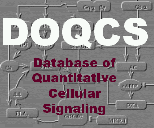| | Name | Initial Conc. (uM) | Volume (fL) | Buffered |
| 1 | PKC-AA* | 0 | 1000 | No |
| | This is the membrane-bound and active form of the PKC-AA complex. |
| 2 | PKC-basal* | 0.02 | 1000 | No |
| | This is the basal PKC activity which contributes about 2% to the maximum. |
| 3 | PKC-Ca | 0 | 1000 | No |
| | This intermediate is strongly indicated by the synergistic activation of PKC by combinations of DAG and Ca, as well as AA and Ca. PKC by definition also has a direct Ca-activation, to which this also contributes. |
| 4 | PKC-Ca-AA* | 0 | 1000 | No |
| | Membrane bound and active complex of PKC, Ca and AA. |
| 5 | PKC-Ca-DAG | 0 | 1000 | No |
| | This is the active PKC form involving Ca and DAG. It has to translocate to the membrane. |
| 6 | PKC-Ca-memb* | 0 | 1000 | No |
| | This is the direct Ca-stimulated activity of PKC. |
| 7 | PKC-cytosolic | 1 | 1000 | No |
| | Marquez et al J. Immun 149,2560(92) est 1e6/cell for chromaffin cells Kikkawa et al 1982 JBC 257(22):13341 have PKC levels in brain at about 1 uM. The cytosolic form is the inactive PKC. This is really a composite of three isoforms: alpha, beta and gamma which have slightly different properties and respond to different combinations of Ca, AA and DAG. |
| 8 | PKC-DAG | 0 | 1000 | No |
| | This is a DAG-bound intermediate used in synergistic activation of PKC by DAG and AA. |
| 9 | PKC-DAG-AA | 0 | 1000 | No |
| | Complex of PKC, DAG and AA giving rise to synergistic activation of PKC by DAG and AA at resting Ca. |
| 10 | PKC-DAG-AA* | 0 | 1000 | No |
| | Membrane translocated form of PKC-DAG-AA complex. |
| 11 | PKC-DAG-memb* | 0 | 1000 | No |
| | Active, membrane attached form of Ca.DAG.PKC complex. |
